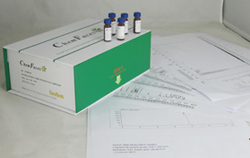Hot Products



| Catalog No. | Information |
| CFN92625 | Anthriscusin Standard reference |
| CFN98539 | Anwulignan Anwuligan has antimicrobial and anticariogenic activity against Streptococcus mutans and other streptococcus species. It also shows antioxidant, free radical scavenging, and neuroprotective activities. (+)-Anwulignan has inhibitory effects on platelets aggregation induced by adenosine diphosphate (ADP) and platelet activating factor(PAF) in vitro. |
| CFN98843 | Apigenin Apigenin is a potent inhibitor of CYP2C9, which has anti-inflammatory, antiangiogenic, and anti-cancer effects, it may inhibit EV71 replication through suppressing viral IRES activity and modulating cellular JNK pathway. |
| CFN95276 | Apigenin 4'-O-(2'',6''-di-O-E-p-coumaroyl)glucoside |
| CFN99416 | Apigenin 4'-O-rhamnoside Apigenin-4'-O-rhamnosylglucoside can strongly inhibit the classical pathway of the complement system. |
| CFN98352 | Apigenin 5-O-beta-D-glucopyranoside Apigenin 5-O-beta-D-glucopyranoside has inhibitory activity against the enzyme yeast a-glucosidase, withthe IC50 value of 287.12 muM. |
| CFN95360 | Apigenin 6,8-di-C-alpha-L-arabinopyranoside Apigenin 6,8-di-C-α-L-arabinopyranoside (Apigenin 6,8-di-C-arabinoside) is a natural C-glycosylflavone compound |
| CFN90918 | Apigenin 6-C-alpha-L-arabinopyranosyl-8-C-beta-D-xylopyranoside Apigenin 6-C-alpha-L-arabinopyranosyl-8-C-beta-D-xylopyranoside is a natural product from Viola yedoensis. |
| CFN90671 | Apigenin 7-O-(2G-rhamnosyl)gentiobioside Apigenin 7-O-(2G-rhamnosyl)gentiobioside is a natural product from Lonicera japonica Thunb. |
| CFN95163 | Apigenin 7-O-(6''-O-malonylglucoside) Reference standards. |